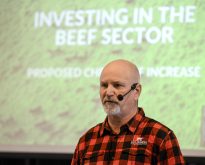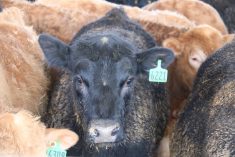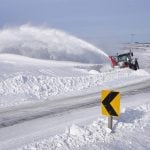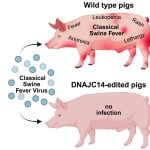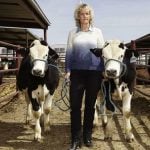The far-reaching drought in Canada is sparking widespread mental health concerns for livestock and cash crop farmers.
The pressure for livestock producers in north-western Ontario and the Prairies to secure feed to get through the summer increased as hay and forage fields scorched, crops were stunted and water sources ran dry into July. Winter feed costs and availability are looming worries.
Why it matters: Drought is a major economic risk for farms, but it also has mental health implications for farmers and their families.
Read Also

Packer buys Green Giant, Le Sieur veg brands from U.S. owner
A Quebec-based processor’s deal to buy the Green Giant and Le Sieur packaged and frozen vegetable brands in Canada from a U.S. owner clarifies the status of two popular retail brands grown by Canadian farmers.
“We’re really worried about our producers who obviously have never experienced anything of this magnitude ever before in Ontario,” said Rob Lipsett, Beef Farmers of Ontario (BFO) president. “We’re being really cognizant of trying to help them with mental health (and) to help them with anything we can.”
Lipsett said farmers understand the magnitude of protecting livelihoods, many of which have been built over several generations. But they may bend to the point of breaking under Mother Nature’s unrelenting will.
When he approached Lisa Thompson after she was appointed Agriculture, Food and Rural Affairs minister, Lipsett said she understood the immediacy of the situation for Ontario producers.
Within seven days, the Northwestern Livestock Emergency Assistance Initiative, colloquially known as Hay North 2021, was crafted and launched at the end of July and the first loads of hay arrived in Rainy River on Aug. 5.
The transfer-payment agreement allowed the BFO to acquire hay, arrange transport to affected areas and distribute it to qualified farmers who applied for relief. To qualify, they must possess a premise ID, a farm business registration number and produce livestock. The program is open to all livestock producers.
“We’ve got more hay gathered up,” said Lipsett. “We’re seeing loads leave on a daily basis now, so hopefully we can get some feed and care and relief to not just the cattle but the farmers in the affected areas right away.”
While Kenora and Rainy River are the current focus, Lipsett said there are drought conditions in pockets throughout the province, including the Ottawa Valley.
He wants those farmers to know they are on the radar and he’s working to find solutions for them too.
The Canadian Federation of Agriculture (CFA)is coordinating with federal and provincial governments, provincial farm and commodity organizations to assess need, prioritize the hardest-hit areas nationally, and craft an effective rollout strategy for Hay West 2021, said Keith Currie, CFA first vice-president, and an Ontario farmer.
“It’s not an easy task, but we’re trying to collaborate with all the bodies involved to make sure that if we’re going to do this, it happens as smoothly as possible,” said Currie.
He added that CN and CP railways would play a critical role in expediting the feed volumes necessary to assist affected areas.
The Hay West 2002 campaign launched during the worst drought in 133 years of Canadian record keeping. In addition to a 75 per cent reduction in grain and hay crops, the feed that managed to survive was consumed by swarms of grasshoppers, further threatening three million cattle, horses, bison and wildlife with starvation.
The lack of hay, grazing pasture and low grain yields resulted in approximately $3.6 billion in production losses, prompted mass herd dispersals and forced the Canadian Wheat Board to drop out of world markets and the Saskatchewan Wheat Pool to cut 200 jobs.
A decade later, in 2012, Western producers loaded up hay and forage to help Eastern Canadian farmers hit by drought. More than 200 hay loads assisted 360 livestock producers. Truckers donated upwards of 40 to 45 per cent of the cost back to organizers to ensure hay kept coming even after government subsidies ended.
This year, the sheer geographical heft of the drought has created myriad logistical challenges in coordinating the provincial leaders, agriculture organizations and the federal government to provide support.
In addition, it’s tough to solicit feed until farmers calculate what they can spare.
“Are they able to give some hay up? What’s it going to cost?” Currie said. “And who looks after the distribution of the product when it gets there? So that’s why, unfortunately, it’s not as simple as call somebody up, get a load of feed, and away you go.”
Canadian Cattlemen’s Association president Bob Lowe said his organization doesn’t know how much feed will be needed to help struggling producers weather the drought.
With approximately three million cows requiring daily feed, the shortage could run into two to three million tonnes.
However, that is only an estimate until the shortfall is quantified and insurance claims allow failed crops to be used as livestock feed.
Lowe said he recently spent two hours speaking with a 70-year-old producer in British Columbia who is watching his five-generation ranch burn up.
“He has nowhere to turn. Nowhere to turn,” said Lowe, “so this becomes pretty critical after a while.”
Currie said some farms are already using feed they gathered this spring for the winter season and are considering culling their herds. He worries that the mental stress on farmers is underestimated.
Lipsett said the BFO has encouraged its members to reach out to family, friends and neighbours if they are struggling.
“If you feel melancholy or anything out of the ordinary, please reach out to anyone, someone you trust. Talk it out,” he said.
“Every once in a while, take that breath, take that time to regroup. We don’t need a tragedy turning into an even greater tragedy. Please take care of each other and yourself.”





